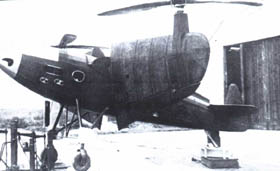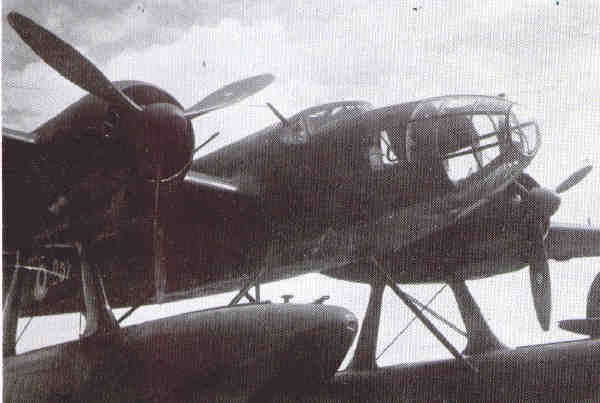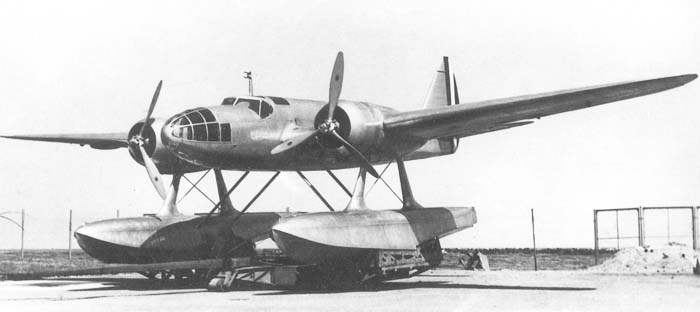Dear Librarian,
referring to my above post #436 let me inform you that, being misled by an editorial of Aviastar, I quoted as denomination of aircraft in question LAR GR-2.
The correct denomination is instead QR2/bis(where QR stand for the initials of Ingegneri Queirolo and Recanatini).
It was an immediate postwar racer (registered I-BICI) that still flew from her homeairport of Linate in the fifties. Powered by a FIAT engine, of wooden construction.
I obtained this information from an another aviation geek.
The above leads me to quote Marziale (Epigrammi II, 86):
Difficiles nugae
carson1934
Nec fieri potest, ut ibi messis sit, ubi satum non est, carissime amice! 
Nevertheless, I do agree with you: it really seems that additional clues will be highly useful in this case. Therefore - no problem, here is another one: that highly intriguing airplane actually was tested at Guidonia back there in 1935. 
Hello Librarian
Could it be a creature of those forgotten geniuses Ing. Piero Magni or Ing. Alberto Jona?
carson1934
Indocti discant et ament meminisse periti (Hénault)
Mutuo ista fiunt, et homines dum docent discunt, Domine Ilustrissime. 
And no, our mysterious airplane actually was a brainchild of a sadly forgotten couple of truly original personalities: inginiere C. Pallavicino, and dottore G. M. Ballerio. 
Honourable Librarian,
although Cicero states:
“Studia adolescentiam alunt, senectutem oblectant” and notwithstanding your valuable clues I am nevertheless right in the middle of a desert.
Therefore as our german friends would say:
“Ich bin am Ende meines Lateins”
Ave, Domine illustrissime
carson1934:(:(
Maxima enim est hominum simper patientia virtus, Domine. Veniet tempus, quo posteri nostril tam aperta nos necisse mirentur. Sursum corda!
Here is another tip for you: that invention which was applied on this tiny machine actually inspired designers of the Do 217! 
Sorry Librarian I’m still in the dark. Maybe another forum member might want to step in and solve the riddle of the mistery plane…
carson1934
Ludus animo debet aliquando dari, ad cogitandum melior ut redeat tibi
Pertinacia impedimentum omne transcendit ostendique nihil esse difficille, Domine! 
I do appreciate your true devotion to the airplane history. Indeed, your passion and inspiration we can use as a true impetus factor for all of us.
Therefore, here is another tip for you, my dear Mr. Carson, hopefully this time much more usable: our secret machine was equipped with the Colombo S 63 engine! 
Dear Librarian,
thanks very much for your continued efforts tending to help me out…I think, thanks to your last clue that I am now in a position to solve the challenge.
I was inclined towards the Breda Ba-39 of which I have three pictures on file but after mature consideration I’m inclined to say Breda Ba/33/S.
carson1934
Ducum volentem fata, nolentem trahunt
P.S. If that’s the one please explain which technical gadget was bestowed upon this aircraft.

Bravo, my dear Mr. Carson! Per rastra ad astra! Yes, the Breda Ba.33 S indeed was our mysterious machine. My sincerest congratulations! 
And here is a tiny explanation about that mysterious and truly innovative invention which is connected with this machine. Basically, my dear Mr. Carson, your fellow-countryman, distinguished G. M. Ballerio, actually discovered a brand new type of air brake – aerodynamic drag-producing device required to obtain a higher rate of descent and improved speed stability.
Usually these devices were incorporated into the wing, but numerous experiments had revealed the fact that they are causing turbulent separation of airflow at the trailing edge of the wing. Brake-generated vortex commonly induced a secondary vortex, powerful enough to force the flow-away from the wing surface. That’s why this innovative device incorporated multifaceted retractable surfaces installed upon the lateral sides of the lower part of the rear-fuselage, being normally completely nested in it. When activated, those surfaces were partly extended into the incoming airflow, thus creating not only instant drag, but also the continuous lateral suction on the outer side of those surfaces, capable to initiate origination of stabilizing lateral pressurization-vortices, strong enough to damp usual tangential instability as well.
Final results were very impressive: Breda 33 S equipped with the aforementioned device was capable to perform a three-point landing over a 10m high gate after only 74 meters! After initial 600 m deep dive air-brakes were activated, thus allowing continuous diving speed of only 140 km/h, without a single manifestation of longitudinal instability. The continuous minimum speed of the Breda 33 S with opened air brakes was only 110 km/h.

Main force-vectors capable to change a momentum of the Breda 33 S equipped with the GMB air brakes
Additionally, the Breda 33 S equipped with this device was capable to perform mushing, or pancaking – to approach the ground in an attitude which we might describe as halfway between a glide and a stall. Stability was preserved in that case as well, without tendency for falling of to the sides.
Additional, highly intriguing experiments were undertaken with a specially prepared Caproni Ca 312 as well, but that story is not connected with our almost completely forgotten old birdie…
And now Sir – please, take the lead! 
Dear Librarian,
thanks to the last clue I was finally able to decipher your mystery plane.
It is with great admiration for your aeronautical knowledge and wisdom and above all for your lucid explanation of the aerodynamic processes provoked by the installation of air brakes into the fuselage of our mystery plane that I, as a layman, was able to comprehend the magnitude embodied in the discovery of our late engineers (now forgotten) and the very fact of substantiating your text with a fully intelligible diagram was the final touch to a well arranged exposition.
Now I am facing the arduous task to find a worthy challenge which, no doubt, I’ll tackle over the forthcoming weekend.
Maxima debetur librario reverentia
carson1934
:D:D
As an addendum to my yesterday’s post I’d like to quote following verses (which I have only slightly amended) which in my opinion seem appropriate to the Breda’s riddle:
"Bis frustra comprensa manus effugit imago (Virgil, Aeneis, VI, v.700)
Dear Mr. Librarian,
Without the ambition of reaching your standards, I am taking the liberty of submitting for identification this strange machine devised by a forgotten scientist, which, notwithstanding every endeavour of the contriver, didn’t fly.
His idea was exhumed half a century later and it worked (to some extent)…
carson1934
Inops, potentem dum vult imitari, perit

I’d very much like to keep this thread active however Librarian (or somebody else for that matter) never responded to my last identification quiz of 6-29-2009 therefore with no posts this part of the forum is coming to a halt.
Not my fault indeed as I’m finding it very interesting
carson:(
Don’t be dismayed Carson! I think most people are vacationing / off on holiday because the armor quiz has been just as silent.
I’ve been a bit stumped… I know what aircraft your offering has spawned, but haven’t figured out its identity yet.
Russ
Proud son of Rose and Wes
Well, Mr Malarz is right about most of us being on vacation. I for one will be away from the computer for most of the time until September, but that does not stop me from hazarding a guess on our latest offer:
Is the mystery aircraft perchance the rather obscure “Aerostatoplne”, an experimental tilt-rotor aircraft developed between the years 1937-39 in Yugoslavia by Russian expatriate Nikolai Zhuchenko?
I have read about this aircraft but never seen any pictures, so there can’t be any harm in guessing it might have looked something like this.
Yes sir it is indeed and I thank you for your interest in the aforementioned challenge.
I myself am going on vacation tomorrow August 1st till end of August therefore I look forward to meeting you all again beginning of September with fresh ideas and instructive threads.
All the best
carson
Have fun on your vacation, Mr. Carson!
Since it’s my turn again, allow me to present you with the next contender:


As a shot from the hip…He 115?
Ah, I had an inkling someone would mention this particular airplane.
Alas, despite the passing resemblance, this mystery bird is not the He 115, a fact immediately discernible if one looks at the differences in glazing of the nose-
HE 115:

Heya, Wings of Wrath!
After a bit of web surfing, I think I’ve come up with a solution…
An Italian Fiat RS. 14?

If not, it’s pretty darn close!
Russ
Proud son of Rose and Wes
